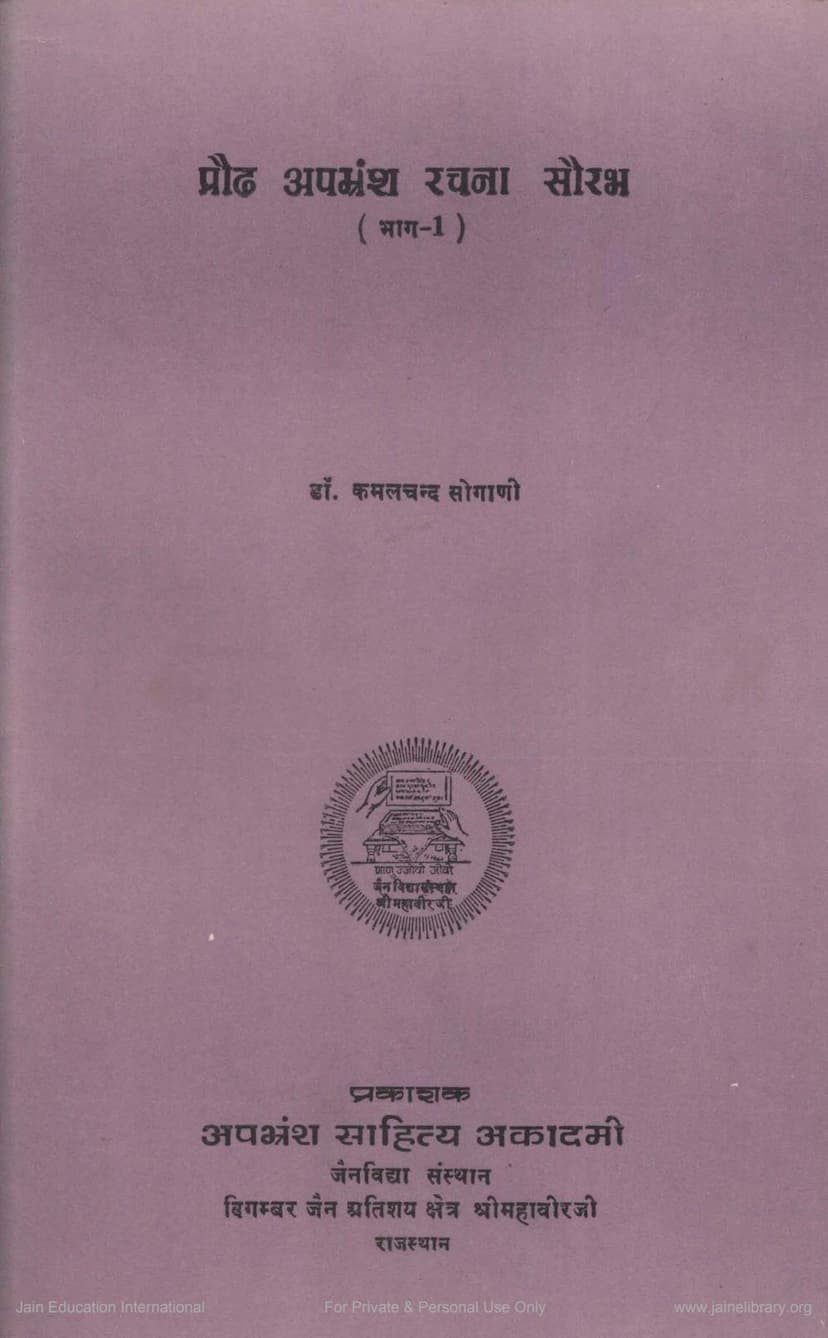Praudh Apbhramsa Rachna Saurabh Part 1
Added to library: September 2, 2025

Summary
Based on the provided text, here is a comprehensive summary of "Praudh Apbhramsa Rachna Saurabh Part 1" by Kamalchand Sogani:
Book Title: Praudh Apbhramsa Rachna Saurabh Part 1 (Meaning: Praudh Apabhramsa Composition Garland, Part 1)
Author: Dr. Kamalchand Sogani (Retired Professor of Philosophy, Sukhadia University, Udaipur)
Publisher: Apbhramsa Sahitya Academy, Jain Vidya Sansthan, Digambar Jain Atishay Kshetra Shrimahavirji, Rajasthan.
Overview and Purpose: The book is dedicated to students of Apabhramsa and aims to provide specific and advanced knowledge of the language. It emphasizes the historical importance of Apabhramsa as the common language of North India from the 7th to the 13th century CE and as the source of many modern Indian languages, including Hindi. The author and publisher believe that understanding Apabhramsa is crucial for a proper understanding of Hindi and other North Indian languages, contributing to national consciousness and unity.
Content and Structure: The book systematically guides learners through various grammatical aspects of Apabhramsa. The table of contents reveals a structured approach, starting with an introduction and progressing to specific grammatical categories:
- Introduction: Includes an "Arambhik" (Beginning) section expressing the joy of presenting the book and highlighting the importance of Apabhramsa. It also mentions the establishment of the Apabhramsa Sahitya Academy in 1988 by the Jain Vidya Sansthan, which primarily teaches Apabhramsa via correspondence.
- Grammatical Topics:
- Adverbs (Avyay): The book covers different types of adverbs, including:
- Locative Adverbs (Sthanvachi Avyay): Words indicating place (e.g., तेत्थ - there, एत्थ - here, केत्थ - where, जेत्थ - where, पासु - near, दूरहो - from afar, उपरि - above, हेट्ठि - below, चउपासें - all around).
- Temporal Adverbs (Kalvachi Avyay): Words indicating time (e.g., तइयहुँ - then, जइयहुं - when, एवहं - now, कइयहुं - when, जाम/ताम - until, अज्ज - today, कल्ले - tomorrow, अणुदिणु - daily, रतिन्दिउ - night and day, भत्ति/छडु - quickly, चिरु - for a long time, पच्छए-पच्छइ - afterwards).
- Modal Adverbs (Prakarvachi Avyay): Words indicating manner or how something is done (e.g., एम/एम्ब - thus, केम - how, तेम - like that, जेम - as, जिह - as, जिह जिह...तिह तिह - as...so).
- Miscellaneous Adverbs (Vividh Avyay): A variety of other adverbs are presented, such as negation (णाहि, न), prohibition (मं), interrogatives (कि), conjunctions (जइ, अहवा), intensifiers (पुणु पुणु), and interjections (भो, अरे).
- Adjectives (Visheshan): The book dedicates significant sections to adjectives, including:
- Cardinal Numerals (Gananavachak Sankhya Shabd): A comprehensive list of numbers from one to one hundred and beyond, with detailed explanations of their declension and usage in different genders and numbers.
- Ordinal Numerals (Kramavachak Sankhya Shabd): Rules and examples for forming ordinal adjectives (e.g., पहिल - first, वीयउ - second, तइयउ - third).
- Miscellaneous Numerical Adjectives (Vividh Sankhyavachi Shabd): Explanations of collective adjectives (both, all), distributive adjectives (double, triple), and indefinite adjectives (some, many).
- Demonstrative and Interrogative Pronouns/Adjectives (Sarvanamik Visheshan): Usage of demonstrative (एत/एम - this, त/तं - that) and interrogative (क/किम - who/what) pronouns, along with their various forms and applications.
- Qualitative Adjectives (Gunavachak): Descriptions of adjectives that denote qualities, with examples of their usage in masculine, feminine, and neuter genders.
- Verb Forms (Kridanta):
- Present Participles (Vartaman Kridant): Explains how to form present participles and their function as adjectives, showing their agreement with the noun in gender, number, and case.
- Past Participles (Bhootkalik Kridant): Details the formation and usage of past participles, distinguishing between those derived from intransitive and transitive verbs, and their role in passive and active voice constructions.
- Adverbs (Avyay): The book covers different types of adverbs, including:
- Grammar Rules (Apabhramsa Vyakarana-Sutra): The book includes a section on Apabhramsa grammar rules, specifically focusing on noun and pronoun declensions. It presents the rules in Sanskrit with detailed explanations of sandhi rules, root words, case endings, and their Apabhramsa derivatives. The methodology involves breaking down the Sanskrit sutras, analyzing their components, providing literal and contextual meanings, and illustrating their usage with examples.
- Exercises (Abhyas): Each chapter or section is followed by exercises, typically involving translating Hindi sentences into Apabhramsa, followed by the provided Apabhramsa translations in the appendices. This reinforces learning through practical application.
- Appendices (Parishisht): These sections contain the translations for the exercises, provide a glossary of relevant grammatical terms, and explain sandhi rules used in the sutras.
Key Features:
- Systematic Approach: The book progresses logically from basic adverbs to complex adjective and verb forms, and then to grammatical rules.
- Practical Application: Ample exercises with translations aid in reinforcing the learned concepts.
- Grammatical Rigor: The inclusion of Sanskrit-based grammar sutras provides a deep and analytical understanding of Apabhramsa morphology.
- Historical and Cultural Context: The introductory sections highlight the significance of Apabhramsa in Indian linguistic history and its connection to national identity.
- Author's Expertise: Dr. Kamalchand Sogani's previous publications in Apabhramsa and Prakrit indicate his significant contribution to the field.
Overall: "Praudh Apbhramsa Rachna Saurabh Part 1" is a comprehensive and scholarly work designed to equip learners with a strong foundation in Apabhramsa grammar. It aims to make the study of this historically significant language accessible and practical, contributing to the preservation and propagation of ancient Indian literary traditions.